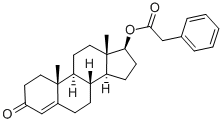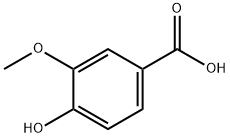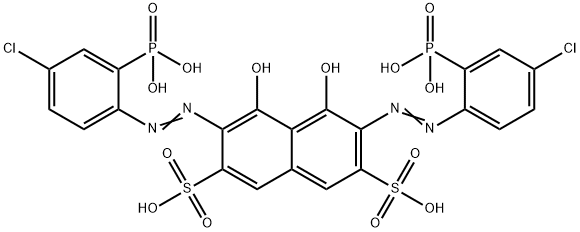Homovanillic acid
Synonym(s):4-Hydroxy-3-methoxyphenylacetic acid;HVA
- CAS NO.:306-08-1
- Empirical Formula: C9H10O4
- Molecular Weight: 182.17
- MDL number: MFCD00004350
- EINECS: 206-176-7
- SAFETY DATA SHEET (SDS)
- Update Date: 2024-12-18 14:15:30

What is Homovanillic acid?
Description
Homovanillic acid (HVA) is a dopamine metabolite. It is formed via deamination of dopamine by monoamine oxidase (MAO) to produce 3,4-dihydroxyphenylacetic acid (DOPAC; ) followed by DOPAC metabolism by catechol-O-methyltransferase (COMT). HVA undergoes hydrogen peroxide-dependent oxidation in the presence of horseradish peroxidase to form a fluorescent dimer that displays excitation/emission maxima of 312/420 nm, respectively. It has been used to quantify hydrogen peroxide production in macrophages and neutrophils.
Chemical properties
white to beige crystalline powder
The Uses of Homovanillic acid
Fluorimetric reagent and major catecholamine metaboliteHomovanillic acid is used as a reagent in the determination of oxidative enzymes. It is associated with dopamine levels in the brain. Its presence supports a diagnosis of neuroblastoma and malignant pheochromocytoma.
The Uses of Homovanillic acid
A neuroendocrine tumor marker. Dihydroxyphenylacetic Acid (DOPAC) metabolite.
What are the applications of Application
Homovanillic acid is Fluorimetric reagent and major catecholamine metabolite
Definition
ChEBI: A monocarboxylic acid that is the 3-O-methyl ether of (3,4-dihydroxyphenyl)acetic acid. It is a catecholamine metabolite.
Biological Activity
Fluorimetric reagent and major catecholamine metabolite. Used for fluorimetric determination of oxidative enzymes including glucose oxidase.
storage
+4°C
Properties of Homovanillic acid
| Melting point: | 142-145 °C(lit.) |
| Boiling point: | 235.56°C (rough estimate) |
| Density | 1.1634 (rough estimate) |
| refractive index | 1.4209 (estimate) |
| storage temp. | Keep in dark place,Inert atmosphere,Room temperature |
| solubility | DMSO (Slightly), Methanol (Slightly, Heated) |
| pka | 4.39±0.10(Predicted) |
| form | Crystalline Powder |
| color | White to beige |
| Water Solubility | soluble |
| Merck | 14,4740 |
| BRN | 2213447 |
| Stability: | Hygroscopic |
| CAS DataBase Reference | 306-08-1(CAS DataBase Reference) |
| NIST Chemistry Reference | Benzeneacetic acid, 4-hydroxy-3-methoxy-(306-08-1) |
| EPA Substance Registry System | Homovanillic acid (306-08-1) |
Safety information for Homovanillic acid
| Signal word | Warning |
| Pictogram(s) |
 Exclamation Mark Irritant GHS07 |
| GHS Hazard Statements |
H315:Skin corrosion/irritation H319:Serious eye damage/eye irritation H335:Specific target organ toxicity, single exposure;Respiratory tract irritation |
| Precautionary Statement Codes |
P261:Avoid breathing dust/fume/gas/mist/vapours/spray. P264:Wash hands thoroughly after handling. P264:Wash skin thouroughly after handling. P280:Wear protective gloves/protective clothing/eye protection/face protection. P304+P340:IF INHALED: Remove victim to fresh air and Keep at rest in a position comfortable for breathing. P305+P351+P338:IF IN EYES: Rinse cautiously with water for several minutes. Remove contact lenses, if present and easy to do. Continuerinsing. P405:Store locked up. |
Computed Descriptors for Homovanillic acid
Homovanillic acid manufacturer
Sintilla Medcoms Pvt Ltd
Syn Finechem Laboratories Pvt Ltd.
BASR Fine Chemicals Pvt. Ltd.
Qualychem
New Products
(S)-3-Aminobutanenitrile hydrochloride 4-Methylphenylacetic acid N-Boc-D-alaninol N-BOC-D/L-ALANINOL Tert-butyl bis(2-chloroethyl)carbamate 3-Morpholino-1-(4-nitrophenyl)-5,6-dihydropyridin- 2(1H)-one Furan-2,5-Dicarboxylic Acid Tropic acid 1-Bromo-3,5-Di-Tert-Butylbenzene S-2-CHLORO PROPIONIC ACID ETHYL ISOCYANOACETATE 2-Bromo-1,3-Bis(Dimethylamino)Trimethinium Hexafluorophosphate 4-IODO BENZOIC ACID 3-NITRO-2-METHYL ANILINE 1-(2,4-DICHLOROPHENYL) ETHANAMINE (2-Hydroxyphenyl)acetonitrile 4-Bromopyrazole 2-(Cyanocyclohexyl)acetic acid 4-methoxy-3,5-dinitropyridine 1-(4-(aminomethyl)benzyl)urea hydrochloride 2-aminopropyl benzoate hydrochloride diethyl 2-(2-((tertbutoxycarbonyl)amino) ethyl)malonate tert-butyl 4- (ureidomethyl)benzylcarbamate Ethyl-2-chloro((4-methoxyphenyl)hydrazono)acetateRelated products of tetrahydrofuran








You may like
-
 Homovanillic acid 98%View Details
Homovanillic acid 98%View Details -
 Homovanillic acid 98%View Details
Homovanillic acid 98%View Details
306-08-1 -
 Homovanillic Acid extrapure CAS 306-08-1View Details
Homovanillic Acid extrapure CAS 306-08-1View Details
306-08-1 -
 Homovanillic acid 98% (HPLC) CAS 306-08-1View Details
Homovanillic acid 98% (HPLC) CAS 306-08-1View Details
306-08-1 -
 Homovanillic acid CAS 306-08-1View Details
Homovanillic acid CAS 306-08-1View Details
306-08-1 -
 4-Hydroxy-3-methoxyphenylacetic Acid CAS 306-08-1View Details
4-Hydroxy-3-methoxyphenylacetic Acid CAS 306-08-1View Details
306-08-1 -
 Homovanillic acid 97% CAS 306-08-1View Details
Homovanillic acid 97% CAS 306-08-1View Details
306-08-1 -
 Homovanillic Acid CAS 306-08-1View Details
Homovanillic Acid CAS 306-08-1View Details
306-08-1